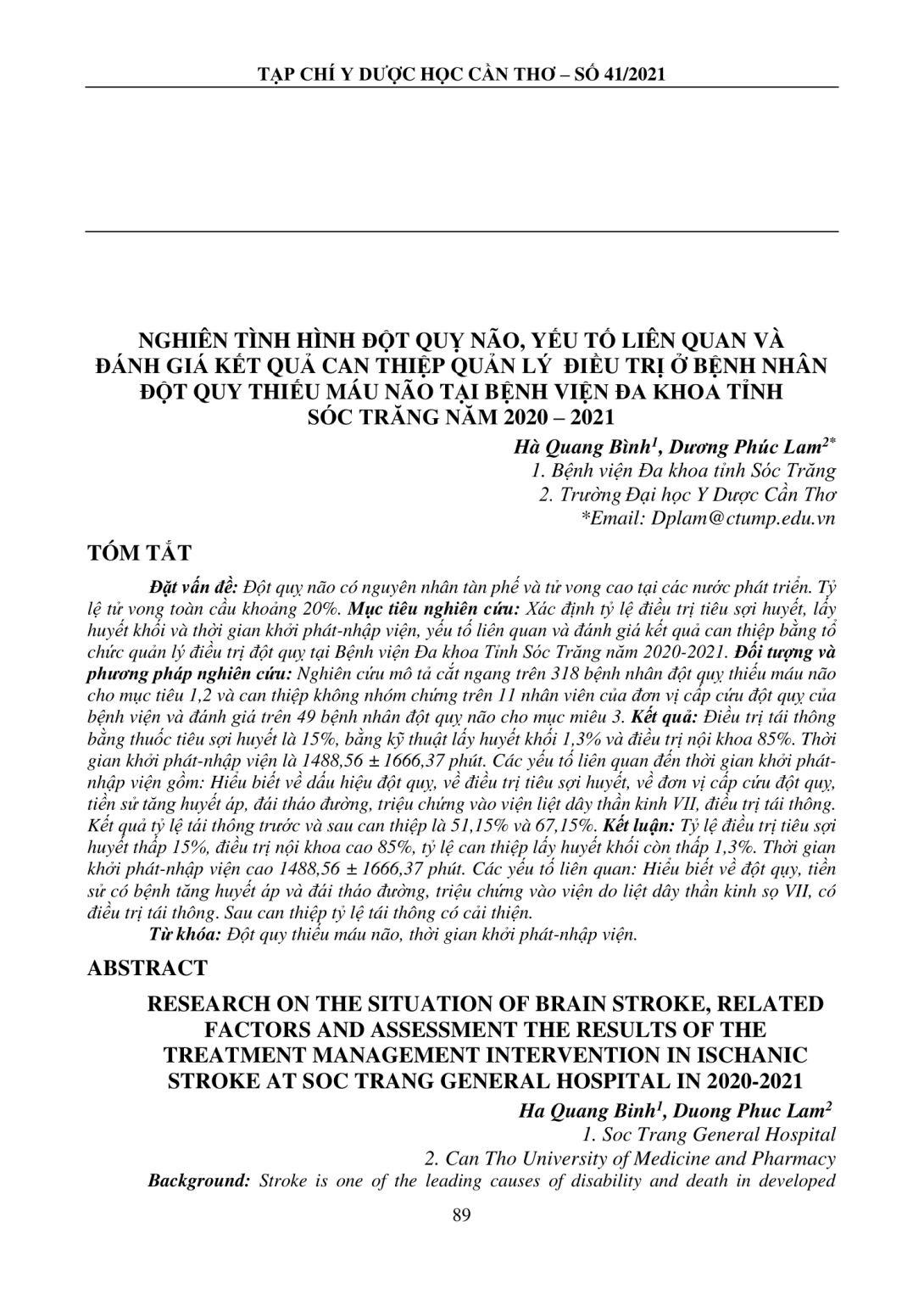
Đột quỵ não có nguyên nhân tàn phế và tử vong cao tại các nước phát triển. Tỷ lệ tử vong toàn cầu khoảng 20%. Mục tiêu nghiên cứu: Xác định tỷ lệ điều trị tiêu sợi huyết, lấy huyết khối và thời gian khởi phát-nhập viện, yếu tố liên quan và đánh giá kết quả can thiệp bằng tổ chức quản lý điều trị đột quỵ tại Bệnh viện Đa khoa Tỉnh Sóc Trăng năm 2020-2021. Đối tượng và phương pháp nghiên cứu: Nghiên cứu mô tả cắt ngang trên 318 bệnh nhân đột quỵ thiếu máu não cho mục tiêu 1,2 và can thiệp không nhóm chứng trên 11 nhân viên của đơn vị cấp cứu đột quỵ của bệnh viện và đánh giá trên 49 bệnh nhân đột quỵ não cho mục miêu 3. Kết quả: Điều trị tái thông bằng thuốc tiêu sợi huyết là 15%, bằng kỹ thuật lấy huyết khối 1,3% và điều trị nội khoa 85%. Thời gian khởi phát-nhập viện là 1488,56 ± 1666,37 phút. Các yếu tố liên quan đến thời gian khởi phát- nhập viện gồm: Hiểu biết về dấu hiệu đột quỵ, về điều trị tiêu sợi huyết, về đơn vị cấp cứu đột quỵ, tiền sử tăng huyết áp, đái tháo đường, triệu chứng vào viện liệt dây thần kinh VII, điều trị tái thông. Kết quả tỷ lệ tái thông trước và sau can thiệp là 51,15% và 67,15%. Kết luận: Tỷ lệ điều trị tiêu sợi huyết thấp 15%, điều trị nội khoa cao 85%, tỷ lệ can thiệp lấy huyết khối còn thấp 1,3%. Thời gian khởi phát-nhập viện cao 1488,56 ± 1666,37 phút. Các yếu tố liên quan: Hiểu biết về đột qụy, tiền sử có bệnh tăng huyết áp và đái tháo đường, triệu chứng vào viện do liệt dây thần kinh sọ VII, có điều trị tái thông. Sau can thiệp tỷ lệ tái thông có cải thiện.
Stroke is one of the leading causes of disability and death in developed countries. The overall global mortality rate is about 20%. Objectives: Determining the rate of thrombolytic therapy to remove thrombosis and time of onset-hospitalization, related factors and evaluation of intervention results in ischemic stroke patients by stroke management organization at the Hospital Soc Trang Province General Hospital in 2020-2021. Materials and methods: A cross- sectional descriptive study on 318 ischemic stroke patients for goals 1,2 and non-control intervention on 11 staff members of the hospital's stroke emergency unit and evaluated over 49 brain stroke patients for item 3. Results: The rate of revascularization with fibrinolytic drugs is 15%, by thrombectomy 1.3% and medical treatment 85%. Onset-hospitalization time is 1488.56 ± 1666.37 minutes. Factors related to Onset-hospitalization time include: Knowledge of stroke signs, fibrinolytic therapy, stroke emergency unit, history of hypertension, diabetes, symptoms of hospitalization VII nerve palsy, revascularization treatment. The results of the recanalization rate before and after the intervention were 51.15% and 67.15%. Conclusion: The rate of fibrinolytic treatment is low 15%, medical treatment is high 85%, the rate of interventional thrombolysis is still very low 1.3%. High onset-hospitalization time 1488.56 ± 1666.37 minutes. The factors related to the onset-hospitalization time: Knowledge of stroke, history of hypertension and diabetes, symptoms of hospitalization due to cranial nerve palsy VII, revascularization treatment. After intervention, the rate of recanalization improved.
- Đăng nhập để gửi ý kiến
